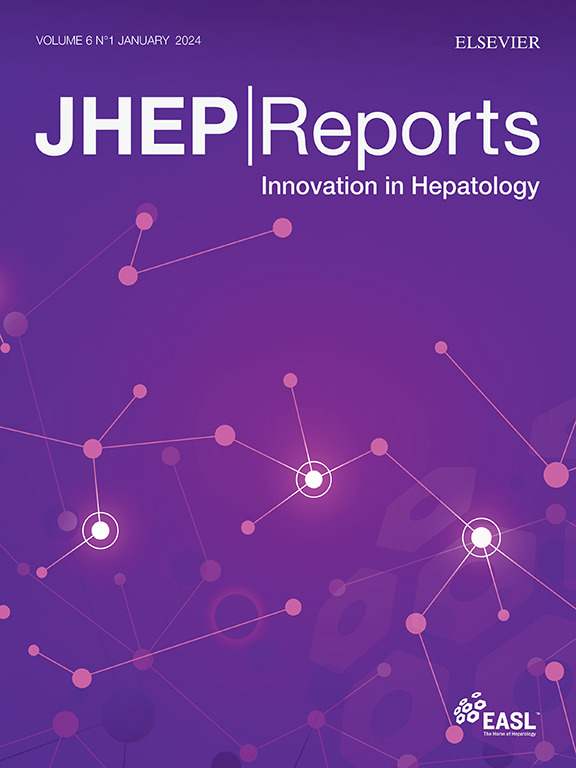Macrophage-derived IL-15 imprints peritoneal TRM-like CD8 T cells in cirrhosis and spontaneous bacterial peritonitis
IF 9.5
1区 医学
Q1 GASTROENTEROLOGY & HEPATOLOGY
引用次数: 0
Abstract
Background & Aims
Tissue-resident memory T cells (TRMs) are long-lived cells poised for rapid immune responses to pathogens. This study assesses whether peritoneal CD8 T cells from patients with cirrhosis exhibit TRM-like functionalities, focusing on how inflammatory events shape phenotype and function.
Methods
Peritoneal CD8 T cell subsets from patients with decompensated cirrhosis were analysed using mass cytometry, flow cytometry, RT-qPCR, single-cell RNA sequencing, in vitro culture, and cytokine profiling. Cells from 87 patients were used, of which 30 experienced spontaneous bacterial peritonitis (SBP). Soluble co-inhibitory (checkpoint) receptors were investigated in cell-free ascites from 80 patients, and TRM-activating cytokines were quantified in peritoneal macrophages.
Results
Unsupervised mass cytometry and subsequent flow cytometry validation confirmed the peritoneal abundance of CD103+ CD69+ CD8+ memory T cells in ascites compared with blood (2.2% vs. 0.4%; p <0.001). TRM-like cells, particularly the CD49a+ subset, were robust producers of interferon-γ (IFN-γ) post-T cell receptor ligation (35.1% vs. 15.3% in CD49- TRM-like cells; p <0.001), and were susceptible to bystander activation by IL-15. Single-cell RNA sequencing revealed tissue residency markers alongside transcriptional signatures of activation and exhaustion in IL-15-exposed peritoneal CD8 T cells. Peritoneal macrophages emerged as IL-15 sources during SBP (ascitic fluid concentration 18.6 pg/ml vs. 8.9 pg/ml; p <0.05), altering TRM-like cell phenotype even after inflammation had subsided. Despite the expression of co-inhibitory receptors, TRM-like cells maintained cytotoxic effector functions in a soluble checkpoint-rich environment, with PD-1/PDL-1 axis blockade not affecting their cytotoxic capacity.
Conclusions
A subset of peritoneal CD8 T cells exhibits TRM-like traits and responds to macrophage-derived cytokines during peritoneal inflammation. TRM-like cells retain potent cytotoxic and proinflammatory responses after SBP resolution, underscoring their role in modulating peritoneal immunity and inflammation in cirrhosis.
Impact and implications
Patients with decompensated cirrhosis exhibit impaired immune responses increasing the risk of spontaneous bacterial peritonitis. This study provides insight into a subset of human peritoneal CD8 T cells in patients with decompensated cirrhosis that have a long-lived and tissue-resident phenotype capable of effectively fighting recognised pathogens within a short period with the help of IL-15 produced by activated macrophages in a bystander fashion. This knowledge has the potential to improve immunomodulatory therapies aiming to enhance peritoneal immune surveillance, and by targeting TRM-like cells and/or IL-15 signalling pathways. In addition, high concentrations of soluble immune checkpoints in ascites should be considered when applying immune checkpoint inhibitors in decompensated cirrhosis.

肝硬化和自发性细菌性腹膜炎中巨噬细胞来源的IL-15印迹腹膜trm样CD8 T细胞
背景,目的:组织驻留记忆T细胞(TRMs)是一种长寿命的细胞,可以对病原体进行快速免疫反应。本研究评估肝硬化患者腹膜CD8 T细胞是否表现出trm样功能,重点关注炎症事件如何塑造表型和功能。方法采用大量细胞术、流式细胞术、RT-qPCR、单细胞RNA测序、体外培养和细胞因子分析方法对失代偿期肝硬化患者腹腔CD8 T细胞亚群进行分析。使用来自87例患者的细胞,其中30例患有自发性细菌性腹膜炎(SBP)。我们在80例患者的无细胞腹水中研究了可溶性共抑制(检查点)受体,并在腹膜巨噬细胞中量化了trm活化细胞因子。结果监督流式细胞术和随后的流式细胞术验证证实腹水中CD103+ CD69+ CD8+记忆T细胞的腹膜丰度与血液相比(2.2% vs. 0.4%;p & lt; 0.001)。trm样细胞,特别是CD49a+亚群,是t细胞受体连接后干扰素-γ (IFN-γ)的强大产生者(在CD49- trm样细胞中分别为35.1%和15.3%;p <0.001),并且易受IL-15的旁观者激活。单细胞RNA测序揭示了il -15暴露的腹膜CD8 T细胞的组织驻留标记以及激活和衰竭的转录特征。腹腔巨噬细胞在收缩压期间作为IL-15来源出现(腹水浓度18.6 pg/ml vs. 8.9 pg/ml;p <0.05),即使在炎症消退后也会改变trm样细胞表型。尽管表达共抑制受体,trm样细胞在可溶性检查点丰富的环境中保持细胞毒效应功能,PD-1/PDL-1轴阻断不影响其细胞毒能力。结论腹膜CD8 T细胞的一个亚群在腹膜炎症过程中表现出trm样特征,并对巨噬细胞来源的细胞因子有应答。在收缩压消退后,trm样细胞保留了有效的细胞毒性和促炎反应,强调了它们在调节肝硬化腹膜免疫和炎症中的作用。影响和意义失代偿肝硬化患者表现出免疫反应受损,增加了自发性细菌性腹膜炎的风险。这项研究提供了对失代偿肝硬化患者腹膜CD8 T细胞亚群的深入了解,这些细胞具有长寿命和组织常驻表型,能够在短时间内有效地对抗识别的病原体,这些病原体是由激活的巨噬细胞以旁观者的方式产生的IL-15的帮助下。这一知识有可能通过靶向trm样细胞和/或IL-15信号通路,改善旨在增强腹膜免疫监测的免疫调节疗法。此外,在失代偿肝硬化中应用免疫检查点抑制剂时,应考虑腹水中高浓度的可溶性免疫检查点。
本文章由计算机程序翻译,如有差异,请以英文原文为准。
求助全文
约1分钟内获得全文
求助全文
来源期刊

JHEP Reports
GASTROENTEROLOGY & HEPATOLOGY-
CiteScore
12.40
自引率
2.40%
发文量
161
审稿时长
36 days
期刊介绍:
JHEP Reports is an open access journal that is affiliated with the European Association for the Study of the Liver (EASL). It serves as a companion journal to the highly respected Journal of Hepatology.
The primary objective of JHEP Reports is to publish original papers and reviews that contribute to the advancement of knowledge in the field of liver diseases. The journal covers a wide range of topics, including basic, translational, and clinical research. It also focuses on global issues in hepatology, with particular emphasis on areas such as clinical trials, novel diagnostics, precision medicine and therapeutics, cancer research, cellular and molecular studies, artificial intelligence, microbiome research, epidemiology, and cutting-edge technologies.
In summary, JHEP Reports is dedicated to promoting scientific discoveries and innovations in liver diseases through the publication of high-quality research papers and reviews covering various aspects of hepatology.
 求助内容:
求助内容: 应助结果提醒方式:
应助结果提醒方式:


